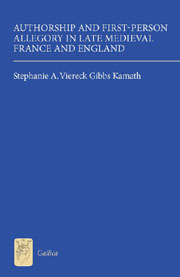Book contents
- Frontmatter
- Contents
- Dedication
- Acknowledgements
- Abbreviations
- A Note on Names, Sources, and Translations
- Introduction
- 1 “Comment ot nom”: Allegory and Authorship in the Roman de la Rose and the Pèlerinage de la Vie Humaine
- 2 “What so myn auctour mente”: Allegory and Authorship in Geoffrey Chaucer's Dreams
- 3 “Thereof was I noon auctour”: Allegory and Thomas Hoccleve's Authority
- 4 Verba Translatoris: Allegory and John Lydgate's Literary Tradition
- Coda
- Bibliography
- Index
- ALREADY PUBLISHED
Introduction
Published online by Cambridge University Press: 05 February 2013
- Frontmatter
- Contents
- Dedication
- Acknowledgements
- Abbreviations
- A Note on Names, Sources, and Translations
- Introduction
- 1 “Comment ot nom”: Allegory and Authorship in the Roman de la Rose and the Pèlerinage de la Vie Humaine
- 2 “What so myn auctour mente”: Allegory and Authorship in Geoffrey Chaucer's Dreams
- 3 “Thereof was I noon auctour”: Allegory and Thomas Hoccleve's Authority
- 4 Verba Translatoris: Allegory and John Lydgate's Literary Tradition
- Coda
- Bibliography
- Index
- ALREADY PUBLISHED
Summary
Le romant de la rose … est louurage tant incorpore en la memoire des hommes que de le coucher en aultre stille ne sera moindre nouuellete que de forgier vng nouuel .a.b.c.
(The Romance of the Rose … is a work so fully incorporated into human memory that to couch it in another style will be no less of a novelty than to forge a new alphabet.)
Jean Molinet, Cest le Romant de la Rose Moralise, fol. 5vThe impact of history is present in every encounter with literature; literary works do not appear in an informational vacuum and are not static in their meaning. Yet the historical relevance of literature cannot be determined simply through reference to a coterminous series of events. The significance of literature depends upon the interactive process of literary reception, which is irreducible to external chronological progress. Literature has its own internal historiography, as authors and readers conceive of their objects through their intertextual experience, through the patterns and innovations of literary traditions. In this book, I trace the history of a seminal literary tradition defined as a network of textual affiliation, concerned not only with the interrelation of texts but also with their representation of that interrelation. My focus rests on the uses of allusion, citation, and translation within texts, rather than on the external timelines and situational preconditions enabling textual interrelation, and my basic assumption is that we are best able to reflect upon the way we engage with literature today when we pursue knowledge of how authors of a past era were reading, “imitating, outdoing, or refuting” as they read.
- Type
- Chapter
- Information
- Publisher: Boydell & BrewerPrint publication year: 2012



